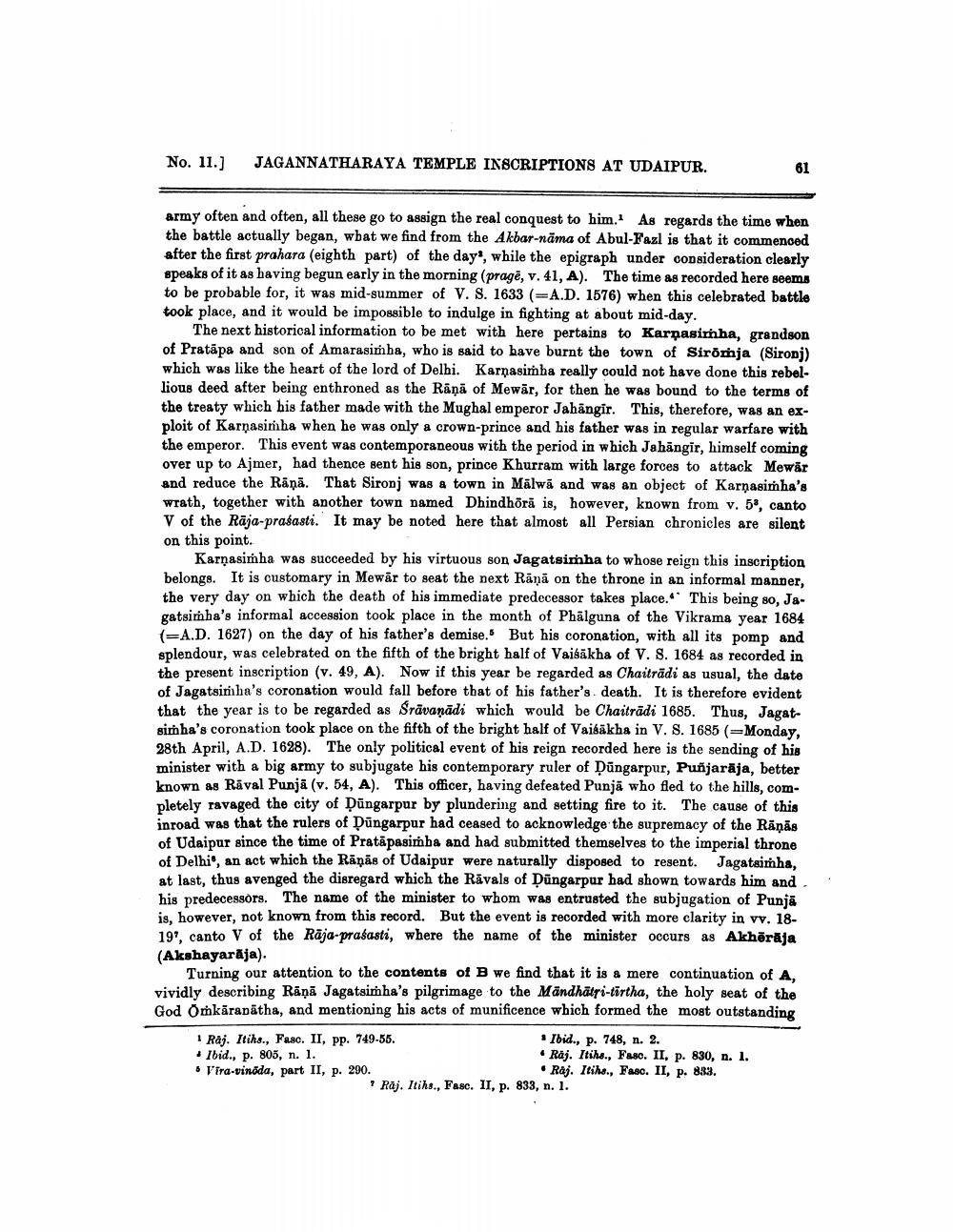________________
No. 11.)
JAGANNATHARAYA TEMPLE INSCRIPTIONS AT UDAIPUR.
61
army often and often, all these go to assign the real conquest to him. As regards the time when the battle actually began, wbat we find from the Akbar-nama of Abul-Fazl is that it commenced after the first prahara (eighth part) of the day, while the epigraph under consideration clearly speaks of it as having begun early in the morning (pragė, v. 41, A). The time as recorded here seems to be probable for, it was mid-summer of V. S. 1633 ( A.D. 1576) when this celebrated battle took place, and it would be impossible to indulge in fighting at about mid-day.
The next historical information to be met with here pertains to Karnasirha, grandson of Pratāpa and son of Amarasimha, who is said to have burnt the town of Siromja (Sironj) which was like the heart of the lord of Delhi. Karnasimha really could not have done this rebellious deed after being enthroned as the Rāņā of Mewär, for then he was bound to the terms of the treaty which his father made with the Mughal emperor Jahangir. This, therefore, was an exploit of Karnasirha when he was only a crown-prince and his father was in regular warfare with the emperor. This event was contemporaneous with the period in which Jahangir, himself coming over up to Ajmer, had thence sent his son, prince Khurram with large foroes to attack Mewar and reduce the Ränā. That Sironj was a town in Malwa and was an object of Karnasimha's wrath, together with another town named Dhindhörā is, however, known from v. 59, canto V of the Räja-prasasti. It may be noted here that almost all Persian chronicles are silent on this point.
Karnasimha was succeeded by his virtuous son Jagatsimha to whose reign this inscription belongs. It is customary in Mewar to seat the next Rāņā on the throne in an informal manner, the very day on which the death of his immediate predecessor takes place. This being so, J&gatsimha's informal accession took place in the month of Phālguna of the Vikrama year 1684
=A.D. 1627) on the day of his father's demise. But his coronation, with all its pomp and splendour, was celebrated on the fifth of the bright half of Vaisakha of V. S. 1684 as recorded in the present inscription (v. 49, A). Now if this year be regarded as Chaitrādi as usual, the date of Jagatsinha's coronation would fall before that of his father's death. It is therefore evident that the year is to be regarded as Srāvanādi which would be Chaitrādi 1685. Thus, Jagatsimha's coronation took place on the fifth of the bright half of Vaisakha in V. S. 1685 (=Monday, 28th April, A.D. 1628). The only political event of his reign recorded here is the sending of his minister with a big army to subjugate his contemporary ruler of Dungarpur, Punjarāja, better known as Raval Punjā (v. 54, A). This officer, having defeated Punjā who fled to the hills, completely ravaged the city of Düngarpur by plundering and setting fire to it. The cause of this inroad was that the rulers of Dungarpur had ceased to acknowledge the supremacy of the Rāņās of Udaipur since the time of Pratāpasimba and had submitted themselves to the imperial throne of Delhi', an act which the Rāņās of Udaipur were naturally disposed to resent. Jagatsimha, at last, thus avenged the disregard which the Rāvals of Dungarpur had shown towards him and his predecessors. The name of the minister to whom was entrusted the subjugation of Punja is, however, not known from this record. But the event is recorded with more clarity in vv. 18199, canto V of the Rāja-prasasti, where the name of the minister occurs as Akhērāja (Akshayarāja).
Turning our attention to the contents of B we find that it is a mere continuation of A, vividly describing Räņā Jagatsimha's pilgrimage to the Mändhātri-tirtha, the holy seat of the God Omkärapätha, and mentioning his acts of munificence which formed the most outstanding 1 Raj. Itins., Fasc. II, pp. 749-55.
• Ibid., p. 748, n. 2. • Ibid., p. 803, n. 1.
Raj. Itihs., Fasc. II, p. 830, n. 1. • V'fra-vinoda, part II, p. 290.
• Raj. Itihs., Fasc. II, p. 883. Raj. Itihs., Fasc. II, p. 833, n. 1.




